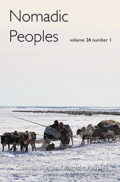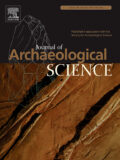Étiquette : Mongolie
-

Kazakh Variations for Herders and Animals in the Mongolian Altai: Methodological Contributions to the Study of Nomadic Pastoralism
Marchina, Charlotte; Zazzo, Antoine; Lazzerini, Nicolas; Coulon, Aurélie; Lepetz, Sébastien; Bayarkhuu, Noost; Turbat, Tsagaan; Noûs, Camille. 2022. “Kazakh Variations for Herders and Animals in the Mongolian Altai: Methodological Contributions to the Study of Nomadic Pastoralism”. in Nomadic Peoples, Vol. 26, N°1, Mars 2022, pp.33-60 Lien vers l’article “Kazakh herders of the Mongolian Altai practice a form of nomadism characterised by high altitudinal…
-
Nomadic Pastoralism among the Mongol Herders
→ Le livre chez l’éditeur Nomadic Pastoralism among the Mongol Herders: Multispecies and Spatial Ethnography in Mongolia and Transbaikalia is based on anthropological research carried out by the author between 2008 and 2016 and addresses the spatial features of nomadic pastoralism among the Mongol herders of Mongolia and Southern Siberia from a cross-comparative perspective. In addition to…
-
The isotope record (δ13C, δ18O) of vertical mobility in incremental tissues (tooth enamel, hair) of modern livestock: A reference set from the Mongolian Altai
→ L’article en ligne 2021 : N. Lazzerini, A. Coulon, L. Simon, C. Marchina, D. Fiorillo, Ts. Turbat, N. Bayarkhuu, C. Noûs, S. Lepetz, A. Zazzo, «The isotope record (δ13C, δ18O) of vertical mobility in incremental tissues (tooth enamel, hair) of modern livestock : A reference set from the Mongolian Altai », Quaternary International, doi: 10.1016/j.quaint.2021.04.008. Identifying the isotopic signatures of…
-

New perspectives for Mongolian studies in France
Friday 22 April, 2022 Meeting between French Mongolists and the National University of Mongolia, on the occasion of the visit to Paris of Mr. Zayabaatar, director of the National Institute of Mongolian Studies at the National University of Mongolia (MUIS). Date: April 22, 2022, 10 a.m.-1 p.m. Location: Campus Condorcet (93322 Aubervilliers – GED &…
-

Date of death of domestic caprines assessed by oxygen isotopic analysis of developing molars: Implications for deciphering the calendar of pastoral activities in prehistory
→ L’article en ligne N. Lazzerini, A. Zazzo, A. Coulon, Ts. Turbat, C. Marchina, S. Lepetz, « Date of death of domestic caprines assessed by oxygen isotopic analysis of developing molars : Implications for deciphering the calendar of pastoral activities in prehistory », Journal of Archaeological Science, 120 The assessment of the date of death (DOD) of animals found in…
-
Tribu d’ailleurs: les Mongols
Le 2 janvier 2020, Charlotte Marchina, maître de conférence en anthropologie, était l’invitée de l’émission Tribu, sur la radio RTS, pour évoquer les éleveurs Mongols et leur rapport à l’espace. → suivez ce lien pour écouter son intervention